| Please access the following URL if you want to secure using SSL. All pages in the site will be secure pages. |
| https://secure02.blue.shared-server.net/www.fish-food.co.jp/message english 2.2020.html |
Welcome to FISH FOOD TIMES
Feb. 2020 issue No.194

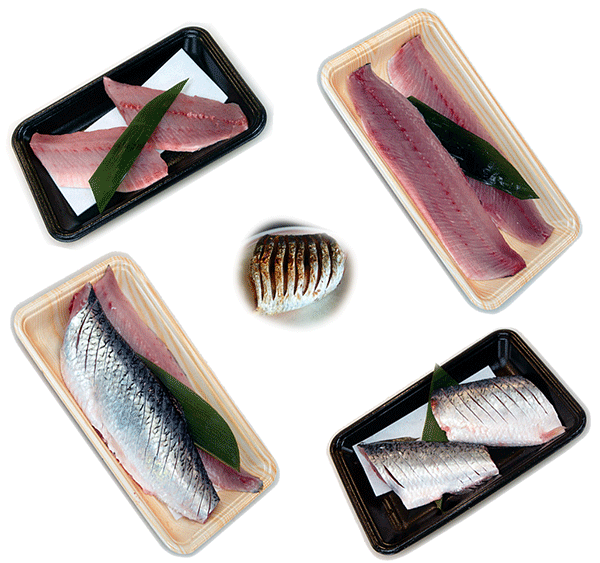
Herring honegiri
Herring catch is recovering
At the end of the year-end sales season, the topic related to Kazunoko may be bitter. However, February is mainly in the area of Otaru, Rumoi and Wakkanai on the Sea of Japan side of Hokkaido, and it is time to start catching herring, a raw material for Kazunoko, so I'll try to cover it in this issue as a seasonal fish article.
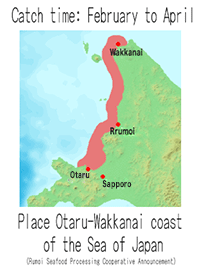
From the end of the 19th century to the early 20th century, herring from Hokkaido to Sakhalin formed a very large resource. And the catch grew more than 400,000 tonnes a year, reaching 970,000 tonnes in 1897. However, as the graph below shows, catches declined dramatically in the middle of the twentieth century, and from around 1975 catches remained at very low levels.
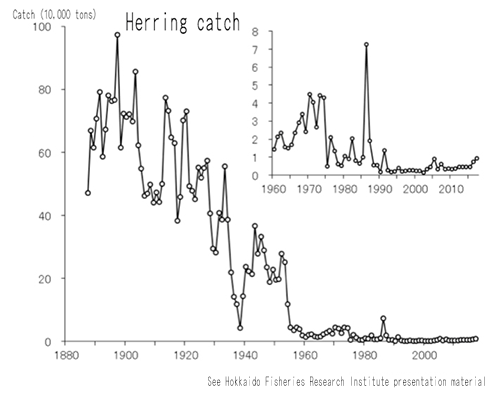
However, in the last five years (2013-2017), catches from coastal fisheries ranged from 2,980�d to 4,775�d per year, and offshore fisheries from 887�d to 5,287�d per year. During this period, the total catch of herring from coastal and offshore fisheries increased from 4,549 �d in 2013 to 9,191 tonnes in 2017, and herring catch has recently been on the rise as shown in the graph below.
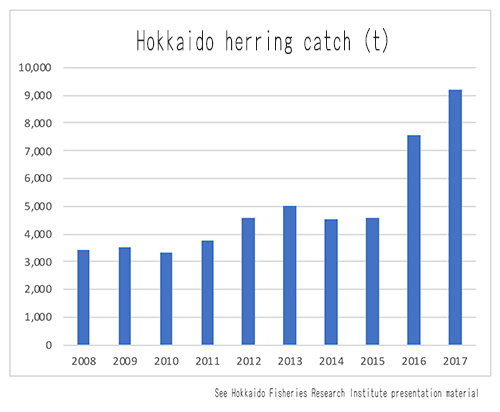
Kazunoko consumption stagnates
Speaking of the increase in herring, Kazunoko, a child of herring called yellow diamond, also increased and became cheaper, at present it does not seem to be a quantity that will affect the price of Kazunoko, and the price is particularly cheap Absent. For comparison, 29,000 tons of frozen herring and 5,477 tons of kazunoko were imported from abroad in the same year in 2017, so even if Japanese herring catch increased, It seem that would doesn't still affect the price of kazunoko powerful.
The salted Kazunoko, called the yellow diamond, has a bright yellow color as shown in the image below, but it is not originally such a color.
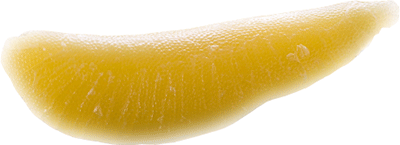
The lower image is the original color.
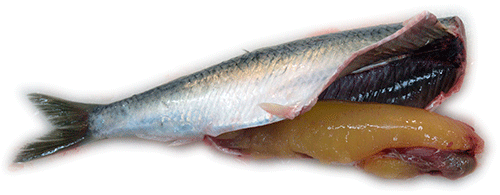
Salted kazunoko is bleached with a chemical called hydrogen peroxide. Hydrogen peroxide is a component of the disinfectant oxyflu, which generates active oxygen and destroys and kills bacterial cells. At the same time, active oxygen has a strong bleaching action because it also destroys pigments.
Because hydrogen peroxide is also carcinogenic, bleached salted kazunoko is decomposed by an enzyme called catalase to remove hydrogen peroxide, and is not shipped as a product unless it is proven that the residual amount is zero. Therefore, the following certificate proves that the residual amount of hydrogen peroxide is zero in the bleached salted kazunoko, which must be attached to the gift box.
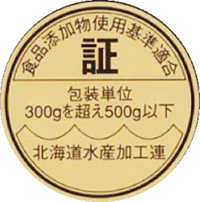
Since the yellow color is brilliant, the apparently bleached salted kazunoko has been in strong demand for gifts. However, consumption has slowed recently due to growing health consciousness of consumers, and production has been gradually decreasing to 2,306 tons in 2017, 2,064 tons in 2018, and 1,950 tons in 2019. On the other hand, consumption of household kazunoko has shifted to unbleached and seasoned products.
ncubated herring, which is the raw material for Kazunoko, mostly relies on imports from abroad.In FY2019, its catch in Alaska Bristol increased by 50%, that of Russia increased by 50%, and that of Canada increased by 4% compared to the previous year. As a result, the price of raw materials was reduced by about 20%. However, prices in Japan remained almost unchanged from the previous year due to increased costs of the Kazunoko processing industry. In a sense, this is considered to be a state of management price for the industry that has been reduced and balanced to survive.
Thus, in an industry environment that focuses solely on the trends of fish eggs, which are herring's most valuable items, are you not interested in herring itself, which seems to be improving resources in Japan? In this month's issue, I'd like to focus on the herring body rather than the expensive fish eggs.
Herring in Japan and the world
According to the description on the AnimalSake homepage, herring is a taxonomic name belonging to the family Clupidae, which has about 200 families. The name herring is used in several members of this family, including the Atlantic herring Atlantic cling (Clupea harengus) and Pacific herring Pacific cling (Clupea pallasii), which belong to the genus Clupea. It is noted that herring accounts for more than half.
The AnimalSake page also shows the habitat of these fish species in the figure below, with a representative herring image below it.
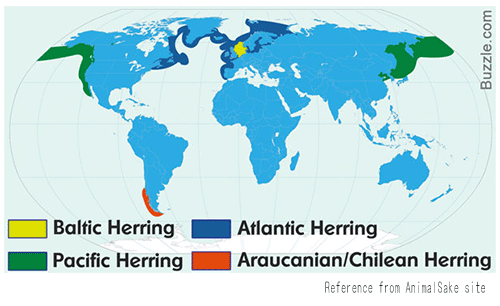
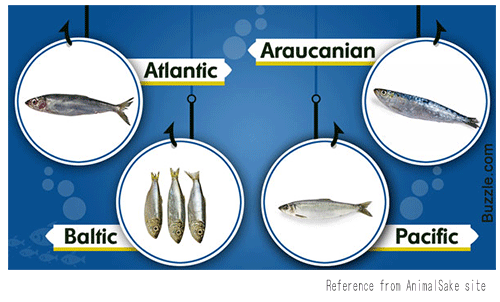
There are two types of Kazunoko that are very hard and not hard. The firm texture of Kazunoko is Pacific herring, and the Atlantic herring Kazunoko is unresponsive and its market value in Japan is low.
I haven't seen the Atlantic herring, the parent of Kazunoko who doesn't feel Chewy, so I will reprint what is described in AnimalSake. According to it, The Atlantic herring can grow up to a length of 18 inches.It is characterized by a fragile and fusiform (tapering at both the ends) body.The dorsal fin can be found midway.It has a greenish or grayish-blue back, and a silvery abdomen.It can be distinguished by its distinctive circle of small teeth located on the roof of the mouth.This fish can weigh up to 1.5 pounds.
Araucania herring and the Baltic herring Baltic herring are also mentioned. The Araucanian herring, also known as the Chilean herring, is dorsally dark blue in color with a silvery abdomen. The Baltic herring is comparatively smaller than its relatives, and grows to a length of only 14 to 18 cm.
The herring that is mainly caught in Japan is the Pacific herring in the image below.

The herringenoid (Clupeiformes) is a taxon of teleost fish, and the lower subherniforms include the sardine, anchovy, Slender shad, and gizzard shad, which look very similar to the sardines. Herring resembles sardines not only in shape but also in freshness quickly, and after a little time, around the eyes becomes red and freshness can be confirmed.
Herring does not last long in the raw state due to its rapid deterioration in freshness, so it was the most reasonable preservation method to remove the internal organs and head and dry it when refrigeration technology had not been developed in the past. Migakinishin is processed as dried fish to distribute herring that has been caught in large quantities throughout Japan. The name "migaki" seems to have been named because it is easier to remove the body of each line when it is returned with water such as rice juice.
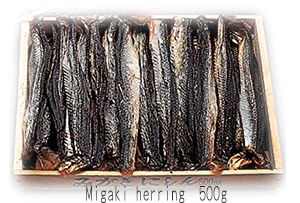
There is a lot of information about the dry matter called Migakinishin in Japan, including how to cook it, so I don't think it is necessary to describe it in detail on this site.
On the contrary, I would like to consider below whether we can make more use of raw herring, which has been increasing in recent years.
Utilize raw herring
The author visits Okinawa every month for work, and this year has been 13 years. In this era, fresh raw fish are being steadily being transported from Hokkaido, the northern end, to the fish section of an Okinawan company that I am teaching. Freshly caught fresh fish, which have just been landed at the port, arrive at the southern end the next day by air cargo. Therefore, you can get as much fresh fish as you can sashimi or sushi at Okinawan stores.
Speaking of whether herring with fast freshness can be made into sashimi or sushi, the hurdles are high and there is no need to do so. However, I would like to propose a herring dish that can not be tasted with dried fish Migakinishin at least as boiled fish or grilled fish.
However, raw herring dishes can be a bottleneck. That is "a lot of small bones".
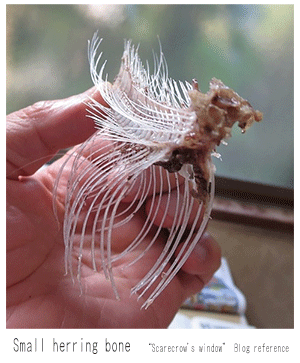
I found this image on a blog called "Scarecrow's Window" and referred to it.
��Omitted ... I knew from a childhood that herring is a fish with many small bones. I ate the whole bone without worrying much. When you get older, the behavior of "swallowing" is getting worse. I'm worried about the small bones I didn't care about in the past. ... Omitted��
It is written in this blog.
Similarly, Slender shad, and gizzard shad, and Japanese grenadier anchovy, which are similar to herring, have many small bones, so they must be pre-processed with a kitchen knife before cooking. So herring can do the same with these same fish. It is a kitchen knife technique called honigiri.
| Herring honegiri | |
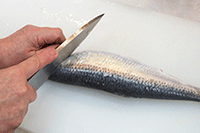 |
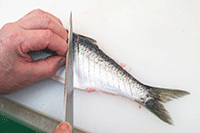 |
| 1�CWith the abdomen on the other side, make a cut in the cross with a deba knife. | 7�CCut into the skin of the upper body with the centralbone at regular intervals, and do the honigiri. |
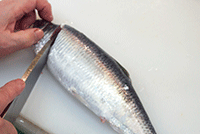 |
 |
| 2�CWith the abdomen facing you, make a cut in the cross and cut off the head. | 8�CA cut is made from the side of the skin to complete the honegiri. |
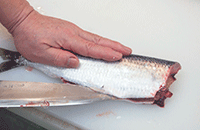 |
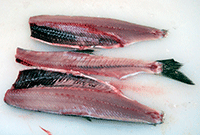 |
| 3�CTo avoid damaging the fish egg, open the abdomen by inverting the knife from the anus. | 9�CThree pieces disassembling with daimyo oroshi's technique. |
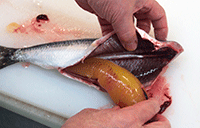 |
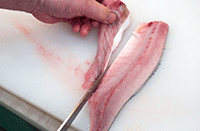 |
| 4�AWhile carefully handling the fish eggs, the internal organs are removed at the same time. | 10�CThe belly bone of the abdomen with many small bones is cut off and removed. |
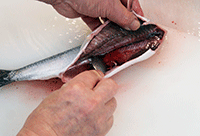 |
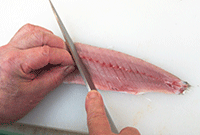 |
| 5�CRemove the blood on the spine of the abdominal cavity and wipe off the water. | 11�CFor the lower body without centralbone, cut with yanagiba knife from fih meat and honegiri. |
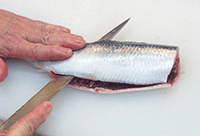 |
 |
| 6�CSeparate the lower body with the technique of daimyo oroshi. | 12�CThe state is that performed Honegiri while leaving one piece of skin. |
 �@�@�@ �@�@�@ |
|
| Commercialization of honegiri herring in two pieces disassembling state | |
 �@�@�@ �@�@�@ |
|
| Commercialization of honegiri herring in three pieces disassembling state | |
Is raw herring widely used?
The phenomenon of herring gathering on the shore in large groups for spawning and whitening the sea surface by spawning and fertilization is called "Kuki". In the past, this phenomenon, which was always seen every year in the waters near Hokkaido and has been discontinued for a long time, has been occasionally seen in recent years, which is said to be a sign of the resurrection of herring catch .
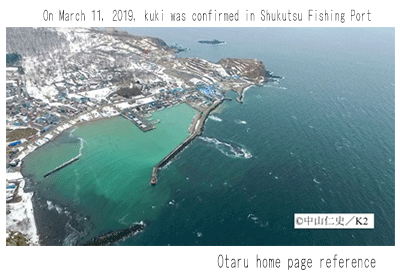
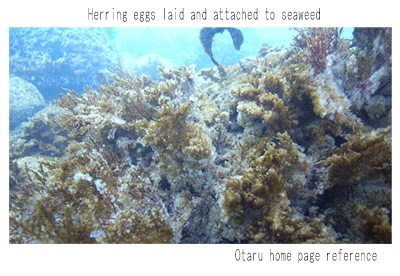
It is unclear at this time whether herring catch will return to nearly 1 million tonnes in the past, and a full-fledged herring catch recovery may still be a dream story. However, similarly, the sardine species of the multi-harvest fish species were once called `` phantom fish '', but in recent years there have been cases where catching has been revived at a remarkable momentum, and I think it may be that herring has similarly increased in the future.
What will happen to herring fishing starting in February of Reiwa 2 and kuki will be seen again this year? If you can see kuki over and over again in Hokkaido, we would like you to focus on fresh shipments instead of freezing or processing migaki herring.
In recent years, autumn salmon and saury have been historically unfished, and sales of the fish section have been declining. In the fish section, besides sardines, there is a real desire for merchandise that can be sold at popular prices, so fresh shipment of herring to all parts of the country should lead to reasonable sales.
As mentioned earlier, fish landed in Hokkaido can be delivered to the fish section in Okinawa the next day. It would not be impossible to make herring sashimi and sushi available in Okinawa by using the recently advanced freshness management technology. Actually, Hokkaido sardines are also sold as sashimi and sushi in the fish section of Okinawa.
I do not deny the product of migaki herring, but should we still value the wisdom of using herring that has been around for a long time as a preserved food? In today's era, there should be appropriate food suggestions. For that reason, by focusing on shipping herring raw, the range of herring's food proposals must be significantly greater.
I think honeygiri, which was introduced in this month's issue, is one of the tips to eat delicious herring with many small bones in a raw state. Don't be afraid to try such a simple thing without saying it's a hassle. If you sell products that have been treated this way in advance, customers will surely be pleased.
An opinion and the communication are to iinfo@fish food times
Date of updating 1 Feb. 2020
